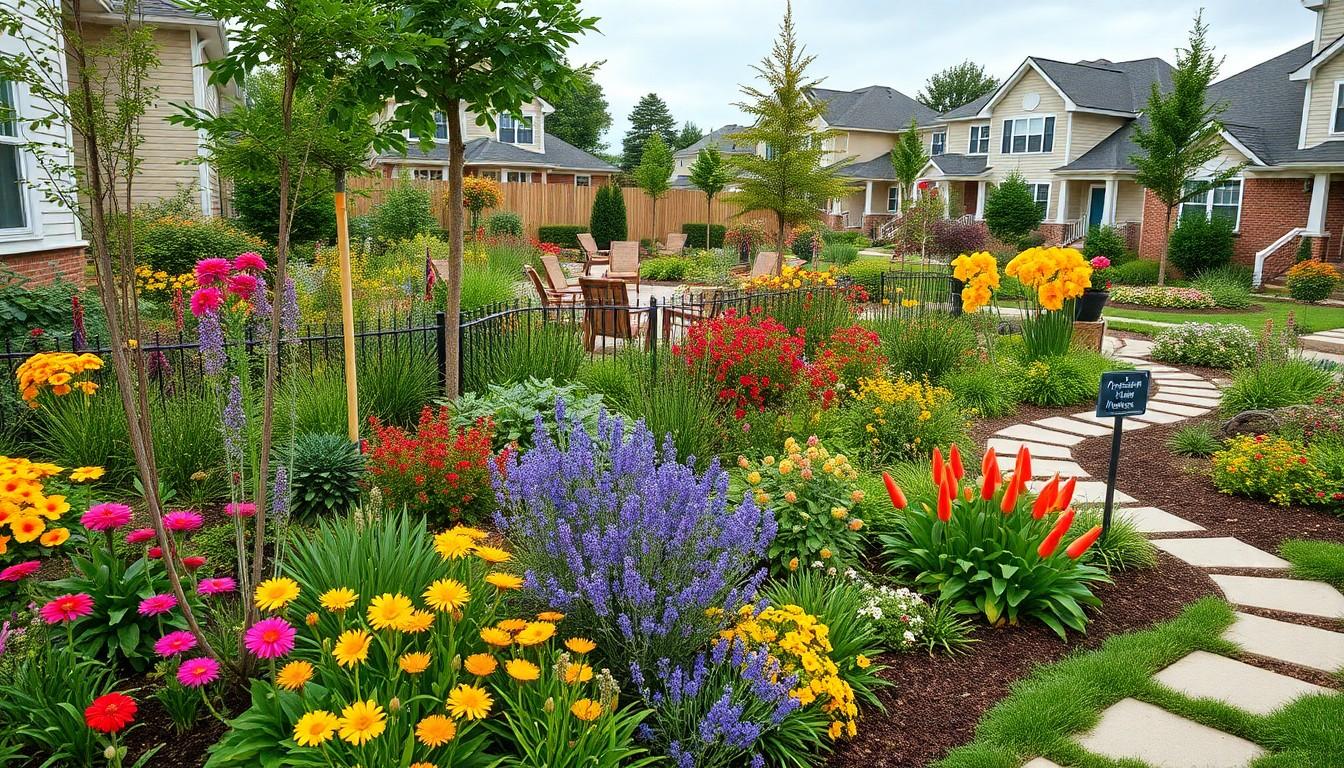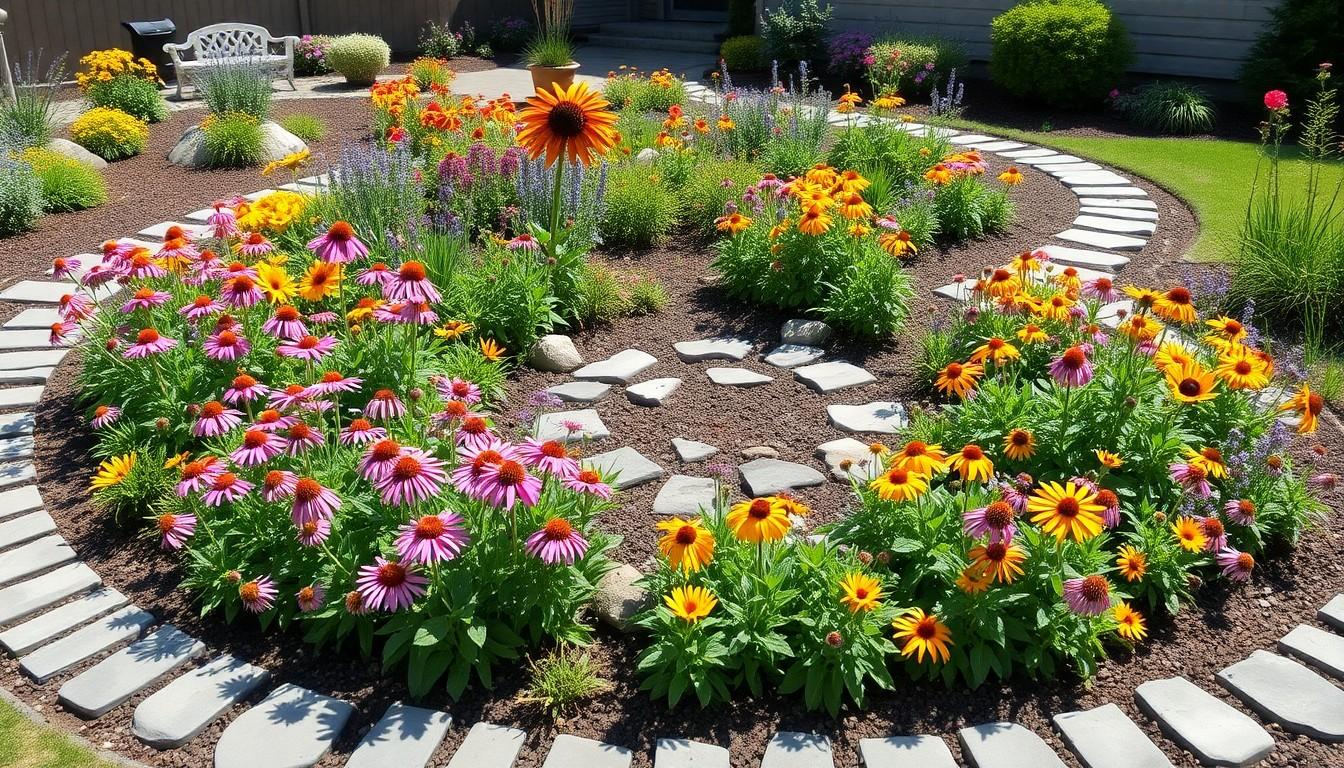Imagine transforming your yard into a vibrant oasis while giving Mother Nature a high-five. Rain gardens are not just pretty patches of plants; they’re eco-friendly solutions that manage stormwater and create habitats for local wildlife. With the right design templates, anyone can turn a soggy spot into a stunning landscape that even your neighbor’s lawn will envy.
Rain Garden Design Templates
Rain garden design templates provide structured guidance for homeowners and landscapers aiming to implement effective stormwater management. These templates vary in size, shape, and plant selection, catering to different landscapes and climates. Various resources, such as online tools and local extension services, offer customizable options to suit individual preferences and environmental conditions.
Templates typically include key elements. First, the layout defines the garden’s shape, determining the flow of water and the overall aesthetics. Second, the plant palette comprises native species that thrive in specific regions. Selecting appropriate plants ensures biodiversity and resilience within the garden ecosystem. Third, many templates provide drainage specifications to optimize water retention and promote healthy soil.
Rain garden design templates often feature inspirational designs that demonstrate functionality and beauty. Some examples incorporate seating areas or pathways, transforming the garden into a usable space. Others emphasize educational components, showcasing native plants’ roles in supporting local fauna.
When applying a design template, considerations include the garden’s location within the yard, proximity to downspouts, and sunlight exposure. It’s essential to assess drainage patterns and existing landscaping features to maximize the garden’s effectiveness. Assessing local regulations and guidelines may also provide valuable insights into optimal design choices.
Utilizing rain garden design templates fosters community involvement and sustainability. Residents can collaborate on shared projects, enhancing overall landscape aesthetics while managing stormwater. Templates inspire creativity and ensure that rain gardens serve their purpose as both functional and attractive additions to any property.
Benefits of Rain Garden Design Templates
Rain garden design templates offer numerous advantages, fostering both ecological health and visual appeal.
Environmental Benefits
Rain gardens significantly enhance stormwater management. They capture runoff, allowing water to soak into the ground and recharge aquifers. Native plants featured in these templates filter pollutants, improving water quality before it enters local waterways. Biodiversity benefits from the habitat these gardens provide, attracting pollinators and other wildlife. By incorporating design elements that optimize drainage, templates encourage effective water retention and minimize erosion. These gardens not only decrease the urban heat island effect but also contribute to more resilient ecosystems by reducing reliance on traditional drainage systems.
Aesthetic Benefits
Visually striking landscapes stem from well-designed rain gardens. Templates inspire colorful, diverse plant selections that create seasonal interest. A harmonious blend of shapes and textures enhances overall garden appeal. Visitors often appreciate the unique character of these gardens, promoting community pride. Incorporating features such as seating areas and pathways invites social interaction and recreation. Rain gardens serve as focal points, drawing attention while maintaining their practical stormwater management purpose. Overall, these templates merge functionality with beauty, transforming ordinary yards into captivating environments.
Key Elements of Successful Rain Garden Design
Rain gardens thrive on careful planning and attention to essential design elements. Effective rain garden design hinges on selecting the right plants and ensuring optimal soil composition.
Plant Selection
Choosing native plants creates a suitable environment for local wildlife and enhances biodiversity. Plants like purple coneflowers, black-eyed Susans, and marsh marigolds tolerate both wet and dry conditions. Selecting a variety of species ensures year-round visual interest and supports various pollinators. Additionally, grouping plants with similar water needs simplifies maintenance while promoting healthy growth. Incorporating deeper-rooted plants can help improve soil structure and water infiltration. Using design templates can guide the selection process and provide a smart framework for overall aesthetic appeal.
Soil Composition
Soil composition significantly impacts drainage and plant health. Well-draining soil mixes with organic matter enhance moisture retention while preventing waterlogged conditions. Combining sandy loam and compost promotes nutrient exchange, fostering robust plant growth. Testing existing soil helps determine necessary amendments for improved performance. Adjusting pH levels and adding organic material improve soil structure, making it more suitable for a rain garden. Ultimately, paying attention to soil essentials lays the foundation for a successful rain garden.
Common Design Templates
Rain garden design templates offer structured guidance to enhance stormwater management and landscape aesthetics. Here are two popular design approaches that cater to various preferences and spaces.
Simple Rain Garden Design
Simple rain garden designs focus on functionality and ease of maintenance. They typically consist of a central depression to capture runoff and a surrounding ring of native plants. Plants, such as sedges and wildflowers, fit well due to their ability to thrive in wet and dry conditions. Additionally, this design emphasizes a straightforward layout, which makes implementation accessible for beginners. The approach requires minimal excavation and allows homeowners to enhance their yards with minimal effort. Decluttering the space around the rain garden also aids in its aesthetic appeal and overall effectiveness.
Multi-Layered Rain Garden Design
Multi-layered rain garden designs introduce varied plant heights and textures for visual interest. These gardens combine taller plants, such as Joe Pye weed, with shorter species, like daylilies, to create beautiful layers. Landscape architects often recommend this structure, as it provides optimal water absorption and habitat diversity. Integrating features such as stepping stones enhances accessibility, while pathways encourage exploration. This design promotes biodiversity by supporting various wildlife and pollinators, making it an environmentally beneficial option. The thoughtful layering results in a stunning garden scene that draws attention and admiration while effectively managing stormwater.
Tips for Customizing Your Rain Garden
Evaluate the available space before starting a rain garden. Assess the yard’s topography and any existing drainage patterns. Choosing a suitable location enhances effectiveness and minimizes maintenance.
Incorporate native plants that thrive in the local climate. Selecting species like purple coneflowers and black-eyed Susans fosters biodiversity. Grouping plants with similar water needs allows for easier upkeep.
Design for both functionality and aesthetics. Adding varied heights and textures creates visual interest. Features such as stepping stones and pathways promote exploration and enhance accessibility.
Consider seasonal changes when selecting plants. Incorporating species that bloom at different times ensures year-round beauty. Varying foliage colors and sizes provides additional dynamic appeal.
Optimize soil composition for better moisture retention. Mixing organic matter with well-draining soil supports healthy plant growth. Testing existing soil helps identify necessary amendments for optimal conditions.
Utilize templates as a foundation for creativity. Design templates serve as guidelines, allowing personal touches and modifications. Customization promotes uniqueness while still addressing stormwater management needs.
Maintain proper spacing between plants for airflow and growth. Adequate spacing reduces competition for resources and prevents overcrowding. Following recommended guidelines leads to thriving, healthy plants.
Collaborate with local experts or community groups. Engaging with knowledgeable gardeners or landscapers can offer valuable insights. Benefit from shared experiences to improve design effectiveness and sustainability.
Rain garden design templates offer a practical and inspiring way for homeowners and landscapers to create beautiful and functional landscapes. By focusing on native plants and thoughtful design elements, these templates not only enhance aesthetics but also promote environmental sustainability.
The incorporation of features like diverse plant heights and textures can transform ordinary yards into vibrant ecosystems that support local wildlife. With careful planning and collaboration, anyone can turn their outdoor space into a thriving rain garden that effectively manages stormwater while contributing to community pride. Embracing these design templates sets the stage for a greener and more resilient future.


